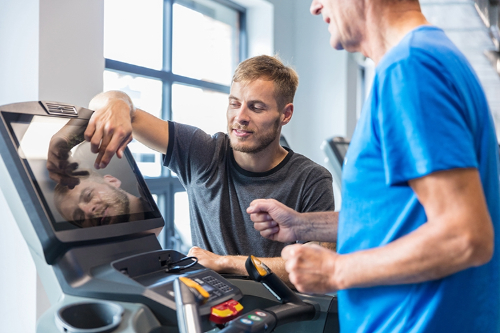How to make the most of cardiac rehab
February 16, 2024
By Endeavor Health
After the trauma of a heart attack or a heart procedure, one of the last things you may want to consider is committing to a months-long follow-up program involving exercise.
Cardiac rehabilitation is a vital component of recovery and helps strengthen patients both physically and mentally. It involves regular, medically supervised exercise, strength training and stretching as well as education on topics like stress management and nutrition.
But cardiac rehab isn’t the bummer it sounds like.

It’s a way to ease into a new, heart-healthy lifestyle, and a team process that can actually end up being kind of fun.
“Cardiac rehab decreases the risk of a future heart event by stabilizing, slowing or even reversing the progression of cardiovascular disease,” said Paul Ruzumna, MD, a cardiologist with Endeavor Health. “The program has a built-in support system of caregivers and fellow patients who often develop a unique camaraderie.”
A cardiac rehab program typically includes three phases led by professionals like registered nurses, exercise physiologists and respiratory therapists.
- Phase 1 focuses on educating patients in the hospital. They receive information regarding their specific heart condition, an activity/home walking program, nutrition, medications, risk factor and lifestyle changes, and emergency planning.
- Phase 2 begins soon after hospitalization. Patients receive an individualized treatment plan and work toward their goals with the cardiac rehab team. Patients attend an exercise program in cardiac rehab, for example 3 times per week for 12 weeks. The sessions usually consist of cardiovascular exercise, strength training and stretching. There is also an educational component that consists of topics such as stress management, nutrition, risk factor management and overall cardiac education. The team monitors each patient’s heart rate and blood pressure, watching for concerns and tracking improvements.
- Phase 3 is a self-directed exercise program. It is important to continue to exercise and make fitness a regular habit.
To maximize your experience in cardiac rehab, keep these points in mind:
- Ask questions. The medical professionals running the rehab program are all ears and want to help. Don’t hesitate to ask them anything.
- Think of it as self-care. Make your rehab appointments “me time.” It’s OK to focus on yourself (and continue that practice once the rehab program ends).
- Let someone know if you have symptoms. Don’t ignore them. Let the medical staff know if you’re feeling off.
- Lean into the team effort. You aren’t doing this alone. Your care team is rooting for you and your peers are working toward similar goals. Cheer each other on!
- Set personal goals. Your care team can help you set realistic personal goals for your rehabilitation. What does success look like to you? What do you want to accomplish? Setting incremental goals will motivate you to keep going.
- Keep it up. Take the healthy habits you developed in rehab home with you and continue to build on your progress. Cardiac rehab may be a short-term program, but the lessons are intended to last the rest of your life.
Your heart is in good hands when you choose Endeavor Health Cardiovascular Institute. Learn more about our cardiac rehab program.
NorthShore University HealthSystem, Swedish Hospital, Northwest Community Healthcare and Edward-Elmhurst Health are now united under one name, Endeavor Health. We’re setting a new standard for healthcare that’s focused on you, because your best health is our endeavor. Learn more.